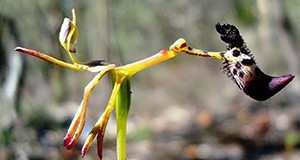Abstract
Orchids and their pollinators have developed fascinating co-adaptations that promote orchid pollination. This 6-page fact sheet details the various and often strange ways that orchids attract pollinators. The kinds of insects and animals that pollinate orchids and orchids’ reproductive anatomies and processes are also covered. Written by Haleigh Ray and Wagner Vendrame, and published by the UF Department of Environmental Horticulture, June 2015.
References
Ackerman, J. D. 1983. "Diversity and seasonality of male Euglossine bees (Hymenoptera: Apidae) in central Panama." Ecology 64: 274 -283. https://doi.org/10.2307/1937075
Brown, P. M. 2005. Wild Orchids of Florida: With References to the Atlantic and Gulf Coastal Plains. Gainesville, FL: University Press of Florida, Gainesville, 432.
Catling, P. M. 1990. "Auto-pollination in the Orchidaceae." In Orchid Biology: Reviews and Perspectives, edited by J. Arditti, 121-158. Portland, OR: Timber Press.
Devey, D. 2008. "Ophrys: A case of the deceitful origin of species." Kew Scientist 33: 1.
DeVries, P. J., and F. G. Stiles. 1990. "Attraction of Pyrrolizidine Alkaloid Seeking Lepidoptera to Epidendrum Paniculatum Orchids." Biotropica 22: 290-297. https://doi.org/10.2307/2388540
Fenster, C. B., and S. Martén-Rodríguez. 2007. "Reproductive assurance and the evolution of pollination specialization." International Journal of Plant Sciences 168: 215-228. https://doi.org/10.1086/509647
Gale, S. 2007. "Autogamous seed set in a critically endangered orchid in Japan: Pollination studies for the conservation of Nervilia nipponica." Plant Systematics and Evolution 268: 59-73. https://doi.org/10.1007/s00606-007-0570-x
Goss, G. J. 1973. "Pollination biology in the Orchidaceae: Polystachia flavescens, Epidendrum difforme, and Eulophia alta from south Florida; Encyclia gracilis, Encyclia altissima,and Encyclia rufa from Great Inagua, Bahamas." Master's thesis, Florida Atlantic University.
Hawkeswood, T. J. and J. R. Turner. 2004. "Observations on Metriorrhynchus rhipidius (Macleay) (Coleoptera: Lycidae) feeding on nectar from the flowers of Leucopogon muticus R. Br. (Epacridaceae) at Kenthurst, New South Wales, Australia." Calodema 2: 8-10.
Johnson, T. R., S. L. Stewart, P. Kauth, M. E. Kane, and N. Philman. 2009. "Confronting assumptions about spontaneous autogamy in populations of Eulophia alta (Orchidaceae) in south Florida: Assessing the effect of population treatments on seed formation, seed germination and seedling development." Botanical Journal of the Linnean Society 161: 78-88. https://doi.org/10.1111/j.1095-8339.2009.00992.x
Kew Royal Botanic Gardens. 2013. "Why should we study orchids?" Kew Royal Botanic Gardens. Accessed 15 April 2015. http://www.kew.org/science/orchids/whystudy.html?words=Breivik.
Kritsky, G. 1991. "Darwin's Madagascan Hawk Moth Prediction." American Entomologist 37: 206-210. https://doi.org/10.1093/ae/37.4.206
Lehnebach, C. A. and A. W. Robertson. 2004. "Pollination Ecology of Four Epiphytic Orchids of New Zealand." Annals of Botany 93: 773-781. https://doi.org/10.1093/aob/mch097
Micheneau, C., J. Fournel, B. H. Warren, S. Hugel, A. Gauvin-Bialecki, T. Pailler, D. Strasberg, et al. 2010. "Orthoptera, a new order of pollinator." Annals of Botany 105 (3): 355-364, doi:10.1093/aob/mcp299. https://doi.org/10.1093/aob/mcp299
Newman, E., B. Anderson, and S. D. Johnson. 2011. "Flower colour adaptation in a mimetic orchid." Proceedings of the Royal Society B: Biological Sciences 279: 2309-2313. https://doi.org/10.1098/rspb.2011.2375
Rasmussen, H. N. 1995. Terrestrial Orchids from Seed to Mycotrophic Plant. Cambridge, U.K.: Cambridge University Press. https://doi.org/10.1017/CBO9780511525452
Roberts, D. L., and K. W. Dixon. 2008. "Orchids." Current Biology 18: 325-329. https://doi.org/10.1016/j.cub.2008.02.026
Scopece, G., S. Cozzolino, S. D. Johnson, and F. P. Schiestl. 2010. "Pollination Efficiency and the Evolution of Specialized Deceptive Pollination Ssystems." The American Naturalist 175: 98-105. https://doi.org/10.1086/648555
Siegel, C. 2011. "Orchids and Hummingbirds: Sex in the Fast Lane." Orchid Digest 75: 8-17.
Statman-Weil, Z. 2001. "Aedes communis: The Pollinating Mosquito." US Forest Service. http://www.fs.fed.us/wild-flowers/pollinators/pollinator-of-the-month/aedes_communis.shtml.
Stökl, J., J. Brodmann, A. Dafni, M. Ayasse, and B. S. Hansson. 2011. "Smells like aphids: Orchid flowers mimic aphid alarm pheromones to attract hoverflies for pollination." Proceedings of the Royal Society B: Biological Sciences, doi:10.1098/rspb.2010.1770. https://doi.org/10.1098/rspb.2010.1770
Wong, B. M. and F. P. Schiestl. 2002. "How an orchid harms its pollinator." Proceedings of the Royal Society of London B 269: 1529-1532. https://doi.org/10.1098/rspb.2002.2052

